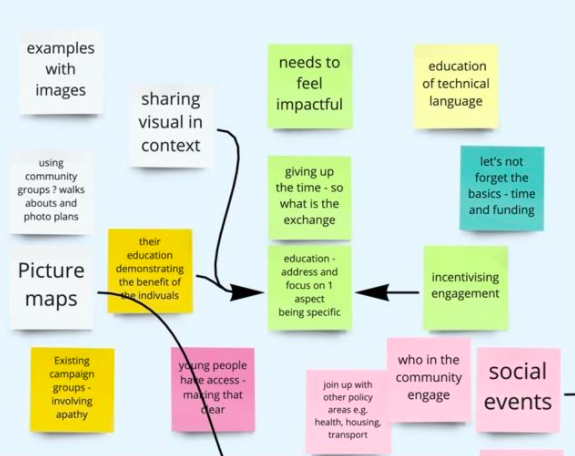Written by:
An event from The Glass-House Community Led Design in partnership with London Forum of Amenity and Civic Societies and Urban Design London
The Ministry of Housing, Communities and Local Government (MHCLG) set out some commendable ambitions in their Model Design Code, which aims to help authorities around the country to raise and maintain high standards of design through the implementation of localised design codes to inform planning and development. They have also been clear in the guidance that there is an expectation that communities should be involved at every stage of setting their local design codes, and even in deciding how they should be engaged.
When preparing design codes, communities need to be involved at each stage of the process….The form and approach for community engagement needs to be decided locally and co-designed with community groups.
National Model Design Code Guidance Notes
Having been fighting for community empowerment in and through design for the past 20 years, The Glass-House can only be pleased about this recommendation. However, while the Model Design Code was being drafted, we expressed considerable concern over how this would work in practice, when there was still so clearly both a skills and resource gap in community engagement in design within the national landscape.
We were not alone, and our reservations are shared by many. Since MHCLG launched the consultation for the Model Design Code in January 2021, there has been much discussion regarding its implementation in practice, as well as a number of events to explore this within sector-specific training and conference settings. The Glass-House has stepped into events on Design Codes organised by and for local authority officers and communities, and it soon became apparent that there was a growing sense of unease across sectors, yet few spaces for the different sectors and disciplines to come together to have a joined up conversation about it.
Creating a space for a cross-sector conversation
To address this gap, we held a free online event Co-designing Design Codes: How could meaningful community engagement work? on 7 October 2021, working with partners London Forum of Amenity and Civic Societies and Urban Design London. We were keen to bring diverse voices across sectors together to explore the opportunities and challenges of engaging communities in formulating local design codes, as well as working together to draft some recommendations. We wanted this to be a safe yet provocative space for discussion and to focus on making practical recommendations on what might help support and enable meaningful community participation and influence.
We gathered a mixed audience, representing various voices within the placemaking landscape including: community organisations and activists; local authority officers and executives; support and umbrella organisations; design professionals; developers; academics, students and researchers and others.
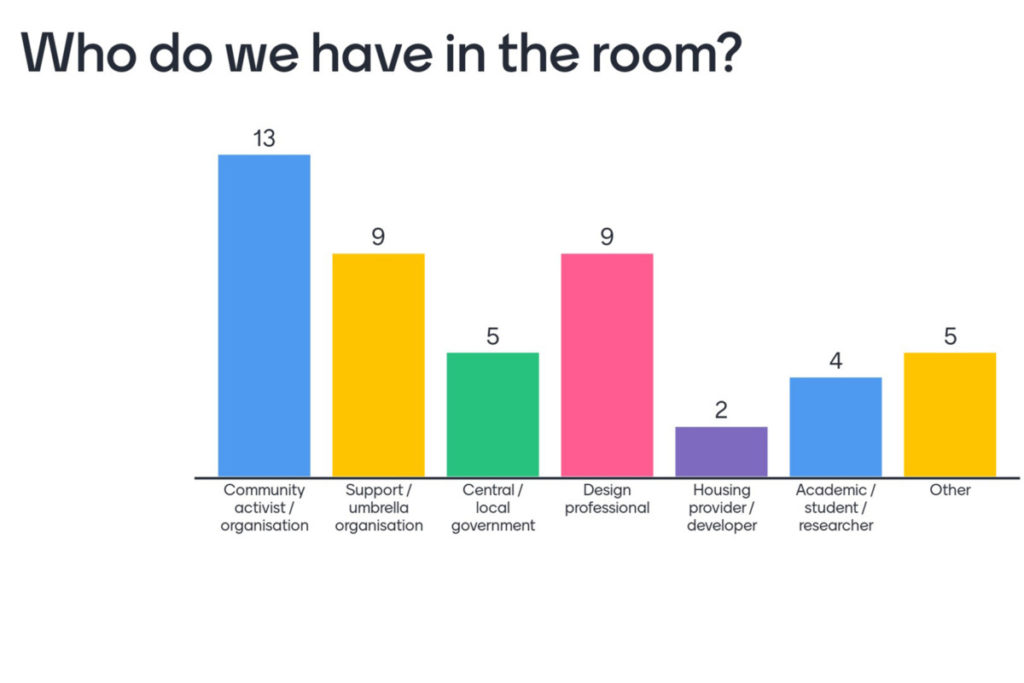
Stimulating discussion and debate
To kick-start our conversation, we invited 3 speakers to share a short provocation. These were 5-minute talks to share views on what each saw as the opportunities and challenges of co-designing design codes with communities, and to put forward their ideas for what might make a difference.
Our first speaker, Sir Steve Bullock, Independent Chair of Place Limited, drew on his experience as a Council Leader noting that while many local authorities are now more willing to engage communities in placemaking processes, they do not generally give people the tools to “meaningfully” engage in the conversation. He talked about the perhaps unrealistic expectation for the average person to engage with planning and design documents, without building capacity within communities to do so, through building familiarity and confidence with the jargon, processes and decision-making matrices in use.
Hana Loftus, Director at HAT Projects, and Engagement and Communications Lead at the Greater Cambridge Shared Planning Services, posed the proposition, “What if we only engaged people under 25?”. Her argument was that given the timescales in placemaking, and that policy and large-scale projects can take a decade or two to manifest into built outcomes, it makes more sense to speak to the people who will live with those outcomes the longest, rather than speaking to the older generations that traditionally engage with planning conversations. She has since outlined her proposition in a blog, which you can read here.
Peter Eversden, Chair of London Forum of Amenity and Civic Societies, returned to the question of whether there is adequate capacity out there to successfully deliver design codes that have been designed with effective community engagement. His focus, however, was on the readiness of local authorities to lead and deliver this process. Following a decade of austerity that has decimated council planning teams, and given a lack of both community engagement skills and dedicated budgets, is it realistic to expect them to be able to quickly mobilise any meaningful engagement process in response to the recommendations in the Model Design Code?
Gathering voices
The event then moved into a space of live polling, aimed at giving each participant an individual voice, and to explore how perceptions of the opportunities and challenges merged and differed across sectors. We asked participants to identify themselves as being affiliated with one or more categories, and for them to share their thoughts from each perspective they represented.
Identifying the OPPORTUNITIES
Here is a snapshot of what we gathered on the opportunities of engaging communities in co-designing design codes:
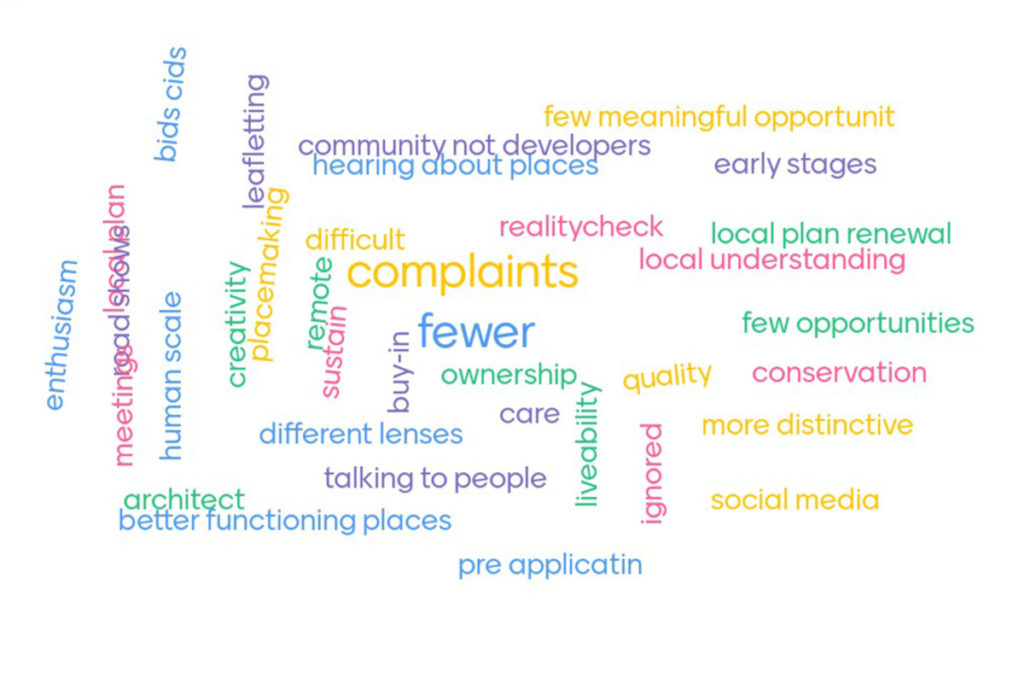


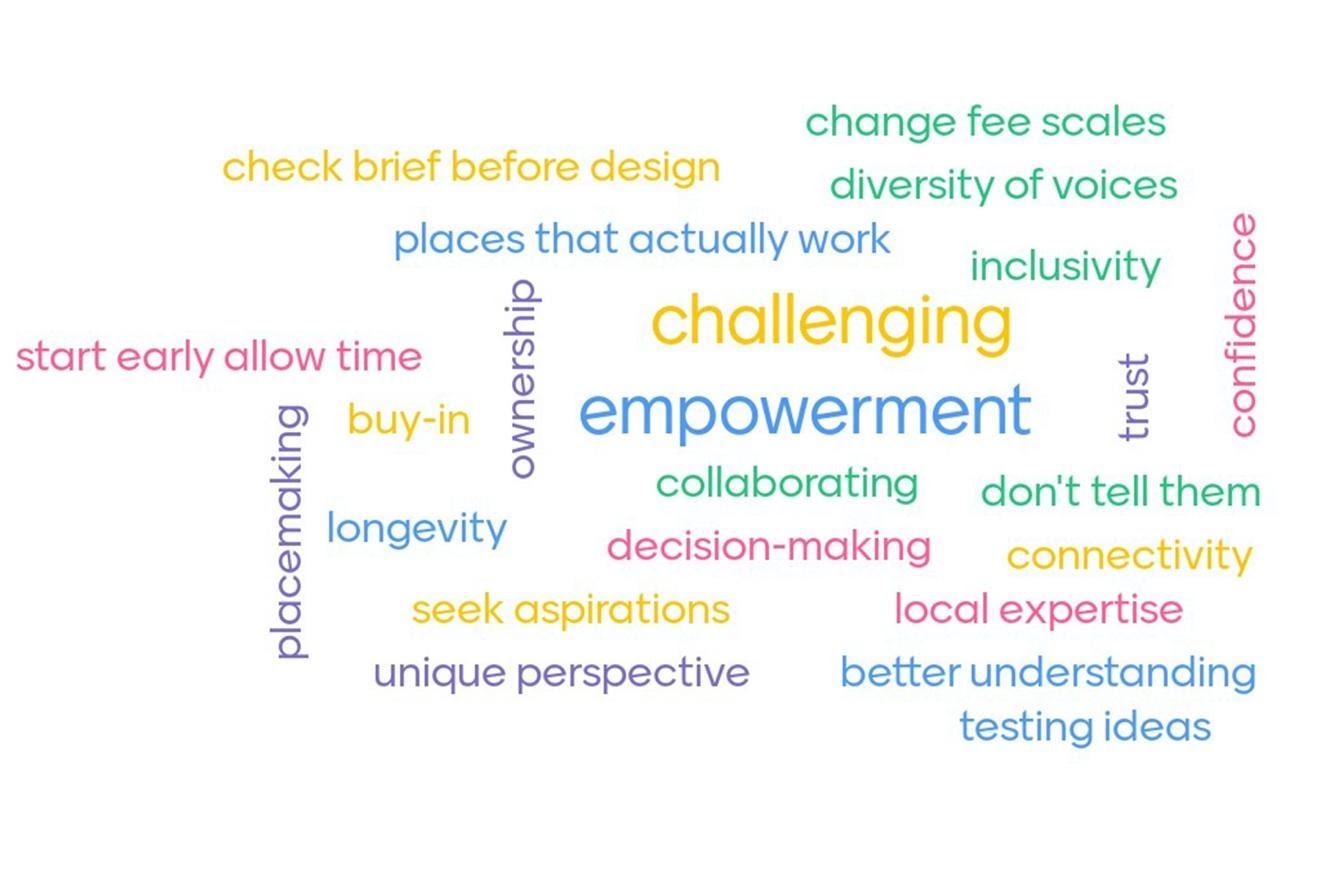


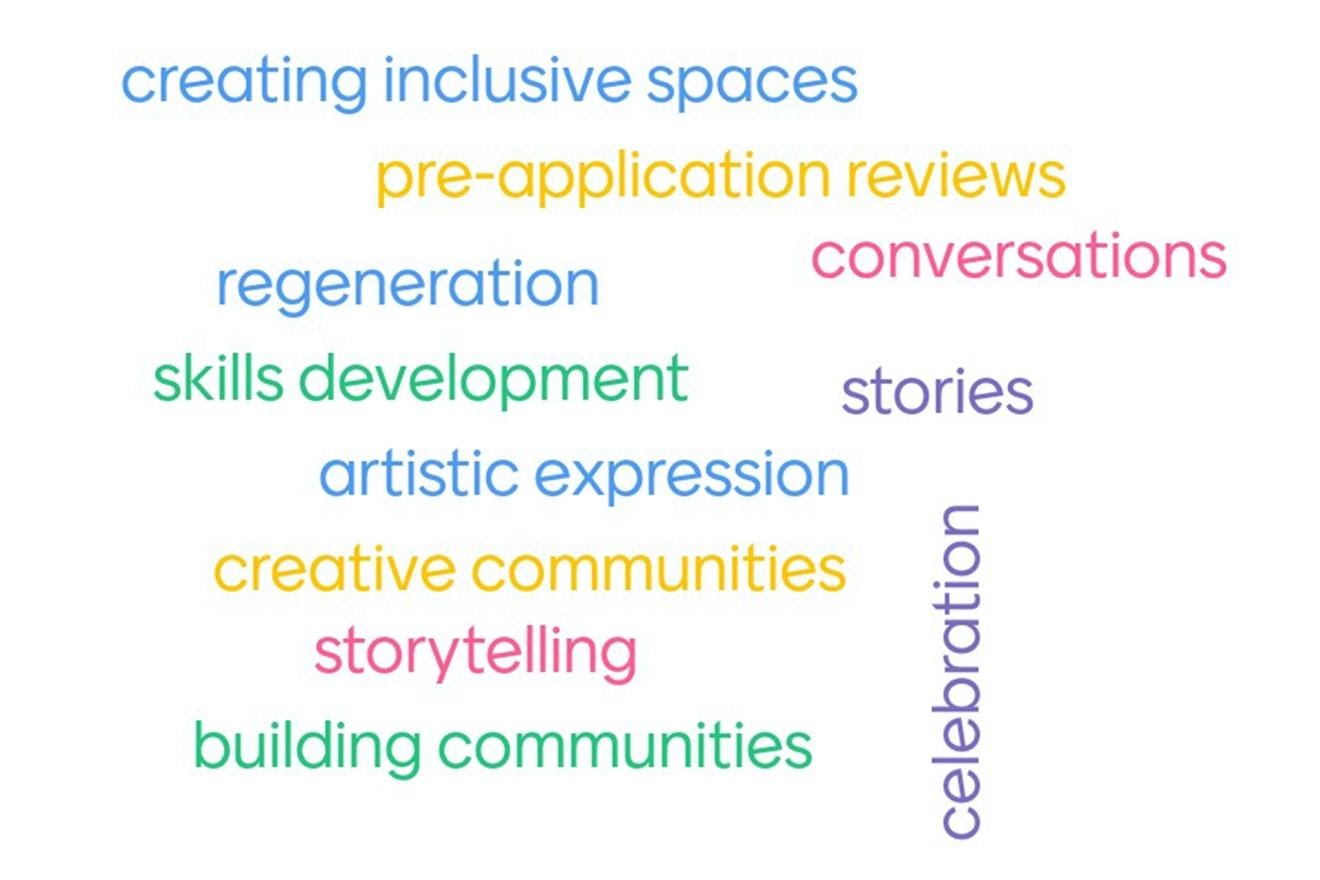
Some consistent themes emerged around the opportunities linked to bringing diverse voices together through a more inclusive, democratic, and empowering process. Other aspects of the opportunities varied more from group to group, from the very practical advantages of building skills, connectivity and achieving buy-in or planning approval to the more evocative notions of storytelling, unlocking creativity and artistic expression.
Identifying the CHALLENGES
Here is a snapshot of what we gathered on the challenges of engaging communities in co-designing design codes:





Developer / housing provider voices on the CHALLENGES of engaging communities in co-designing design codes.


Co-designing recommendations
We were keen to move people from this reflective space to working together to formulate concrete recommendations. Working in four groups of participants representing diverse affiliations, we began by identifying the conditions for effective community engagement in design codes. We then asked each group to come up with at least one practical and practicable recommendation to help us move Design Codes to a productive space for engagement and co-design.
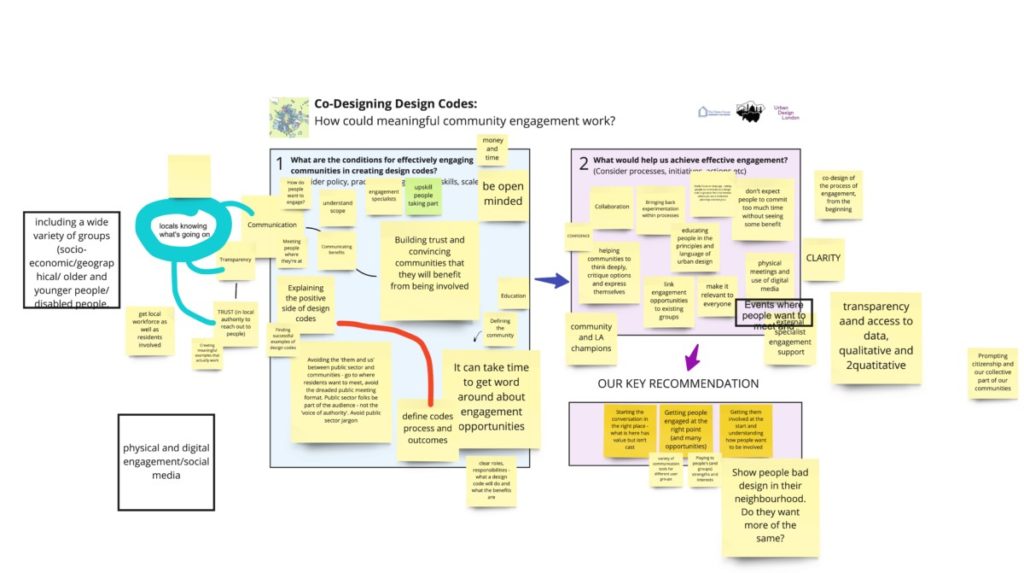
The first group focused on the process and timing of engaging people, stressing the importance of bringing them in at an early stage, understanding how they would like to get involved, creating clear and accessible pathways into the process, and using a variety of analogue and digital tools in order to be accessible to a diverse range of people and organisations.

The second group similarly stressed the importance of clarity of process, but also gave considerable space in their discussion to the players involved. They suggested starting with mapping the local community groups and organisations as means of connecting with wider audiences, building on groups and relationships that are already there, perhaps to form dedicated citizen groups or panels (who should be paid for their time) as well as a dedicated officer role within the council.

Group Three placed a strong emphasis on learning from experience, tapping into the learning that will emerge from the Design Code Pilots, as well as what we have already learned from other processes of engaging communities in the planning process. The group explored the idea of creating a centre of excellence that could provide vital support through sharing learning and connecting different places to each other for peer mentoring.
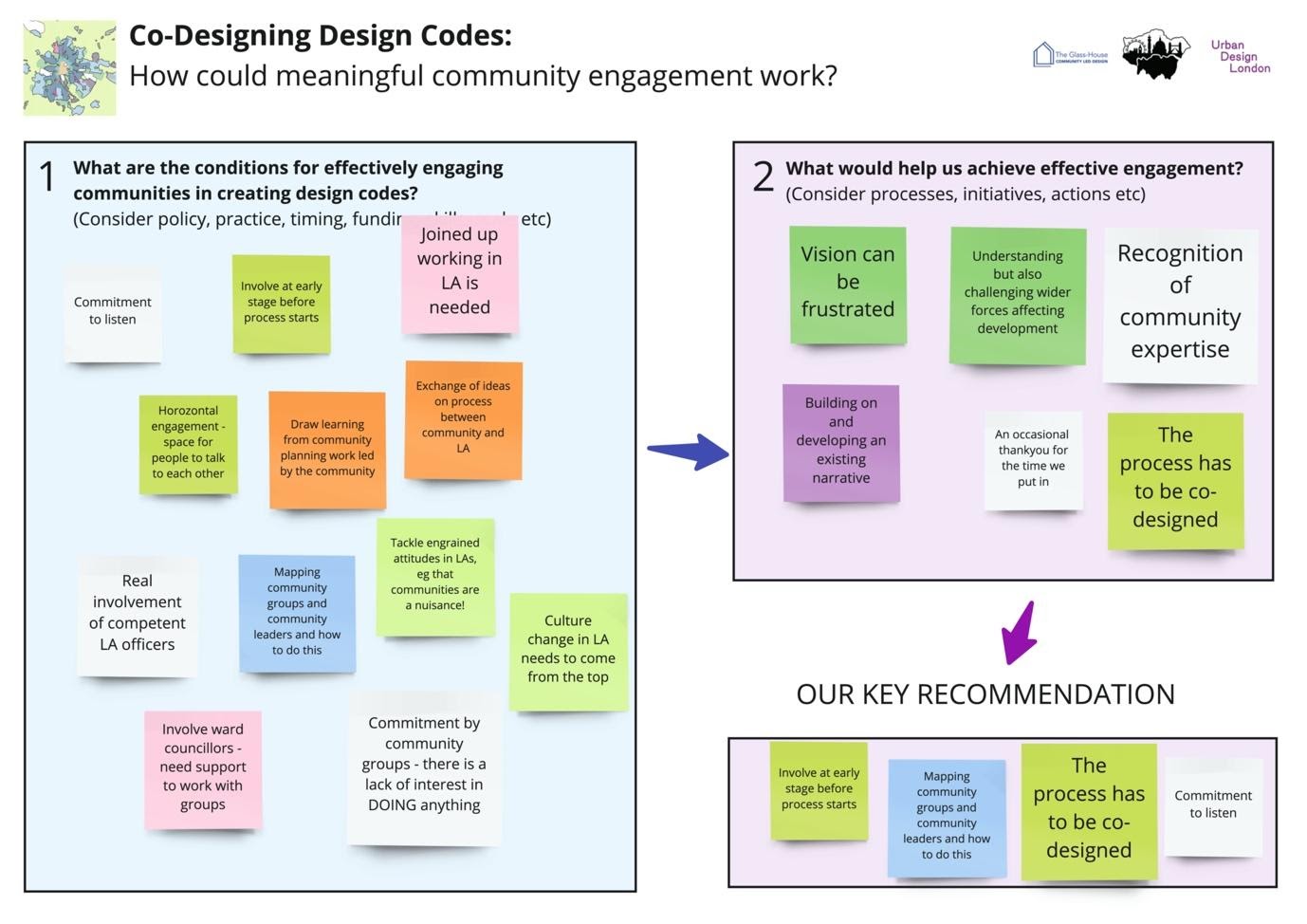
And finally, the fourth group covered many of the same points as other groups, but also brought a clear focus on the importance of co-designing the engagement process itself, and on creating pathways to unlocking the expertise that is present within communities. They spoke of the importance of listening and then translating that into decision-making.
Key takeaways
Before closing the event, and through the feedback process, we asked people to share some of their key learning points from being in this cross-sector and interdisciplinary discussion. Here are some of the key takeaways that were shared, and some questions we felt needed further exploration:
- One of the biggest challenges to engaging people in co-designing design codes is that most have neither heard of them nor have any understanding of how they might get involved in shaping them.
- Design codes could offer an opportunity to get the planning process right up front, to set the rules of the game through them, if we are able to co-design the process of shaping them.
- We absolutely have to learn from the Design Code Pilots and from our collective related experience. Pilot communities sharing their experiences “warts and all” could help us all shape good future practice.
- We want to know more about what both communities and professionals have learnt from past co-design and collaborative planning processes, and how we can apply that learning to this context.
- We need to build an infrastructure for collaboration that supports the co-design of design codes, but that also goes beyond the remit of design codes to connect this conversation into design and placemaking in broader terms.
- Do local authorities have the capacity to mobilise and manage such a process on the timescales envisaged? The general feeling was that most don’t. There is a need to build capacity on effective community engagement within local authorities and among built environment professionals.
- The process of engaging communities in co-designing design codes will need to empower them with the confidence, skills and agency to step into the complex, sector-specific processes and jargon linked to urban design and planning with clear parameters of influence.
- Are there ways we could engage people in design codes in a more focused way, and perhaps for specific crucial elements of it? How can we break the process into smaller, more digestible pieces without losing levels of influence for those engaging?
- Let’s get out of our silos. How can we constantly step out of our comfort zones to interact with people who are different from us, and to exchange knowledge?
- We talked a lot about the “how?”, but we mustn’t forget the “when?”. It’s important to get the conversations going early so that engagement is meaningful and really influences decision-making.
- We need to be really clear about the offer we are making to the communities we are engaging and be able to answer the question, “What’s in it for them?”.
- Can we use design codes to “design in” obligations? How much power can they really wield?
We rounded up the event with the feeling that we need to create the space and time for more conversations like this, which bring different sectors and disciplines together to work collaboratively on how we can make design codes really achieve their ambitions of improving the standard of design through an engagement and democratic process of co-design. The infrastructure for collaboration has to start with an honest conversation that builds understanding and empathy, and that identifies shared values and principles for working together. We must also build on what we collectively already know rather than reinventing the wheel. Between us, we have a huge reservoir of expertise and experience to draw upon.
Please take a look at the event report here, for more information.
We’d like to thank our partners the London Forum of Amenity and Civic Societies and Urban Design London, as well as the many participants who joined us on the day and we hope that our event and capture of it has sown some seeds for further discussion and collaboration.
